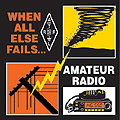 A Simple Wilderness Protocol: 146.52 MHz
A Simple Wilderness Protocol: 146.52 MHz
 “The Wilderness Protocol” (ref. June 1996 QST, page 85), recommends that stations (fixed, portable or mobile) monitor the primary (and secondary if possible) frequency(s) every three hours starting at 7 AM local time, for five minutes (7:00-7:05 AM, 10:00-10:05 AM, etc.) Additionally, stations that have sufficient power resources should monitor for five minutes starting at the top of every hour, or even continuously.” The primary frequency is the National Simplex Calling Frequency…146.52 MHz. The secondary frequencies are 446.0, 223.5, 52.525 and 1294.5 MHz.
“The Wilderness Protocol” (ref. June 1996 QST, page 85), recommends that stations (fixed, portable or mobile) monitor the primary (and secondary if possible) frequency(s) every three hours starting at 7 AM local time, for five minutes (7:00-7:05 AM, 10:00-10:05 AM, etc.) Additionally, stations that have sufficient power resources should monitor for five minutes starting at the top of every hour, or even continuously.” The primary frequency is the National Simplex Calling Frequency…146.52 MHz. The secondary frequencies are 446.0, 223.5, 52.525 and 1294.5 MHz.
Here in Colorado, the summer months mean that many people head for the mountains. Mobile phone coverage has improved in many parts of the high country but is still not reliable in all areas. Amateur radio VHF/UHF repeater coverage is extensive but also does not cover the entire state.
The Wilderness Protocol is a good idea but is overly complex for practical use. Here’s my proposal to make it much simpler for practical backcountry use:
Principle #1: Don’t ever rely on a radio or mobile phone to get you out of trouble in the backcountry. Your primary strategy must be self-sufficiency. Avoid trouble. Be prepared for the unexpected.
Principle #2: Know what repeaters are available in your area. We have many wide coverage repeaters available but you need to know the frequency, offset and CTCSS tone (if any). The Colorado Connection is a linked repeater system that covers many remote parts of the state.
Principle #3: In remote areas, monitor 146.52 MHz as much as possible. This applies to backcountry travelers, mobile stations and fixed stations.
I’ve been making it a habit to monitor 146.52 MHz in the backcountry. I often come across hikers, campers, fisherman, 4WD enthusiasts, SOTA stations, mobile operators and others monitoring that frequency. It is fun to chat with other radio amateurs having fun in the mountains.
Just my opinion.
73, Bob K0NR
Note: This is a repost of an older article with minor edits.













I like your wilderness protocol better. It’s much more realistic and practical.
Those secondary frequencies they list are rather idealistic. Anyone hoping to get saved using 220, even here in the East, is probably out of luck. Does anyone actually monitor 6m FM these days? 50.125 USB is much more widely monitored.
yo envio un saludote grande a todos los compañeros que acostumbran monitorear la banda se 50 mhz,yo me encuentro todos los dias de 20:hrs 23:hrs en 50,125 usb…..73 y Dx…..menny
I love 2 meters,it is awesome, sometimes listening to sporadic skip